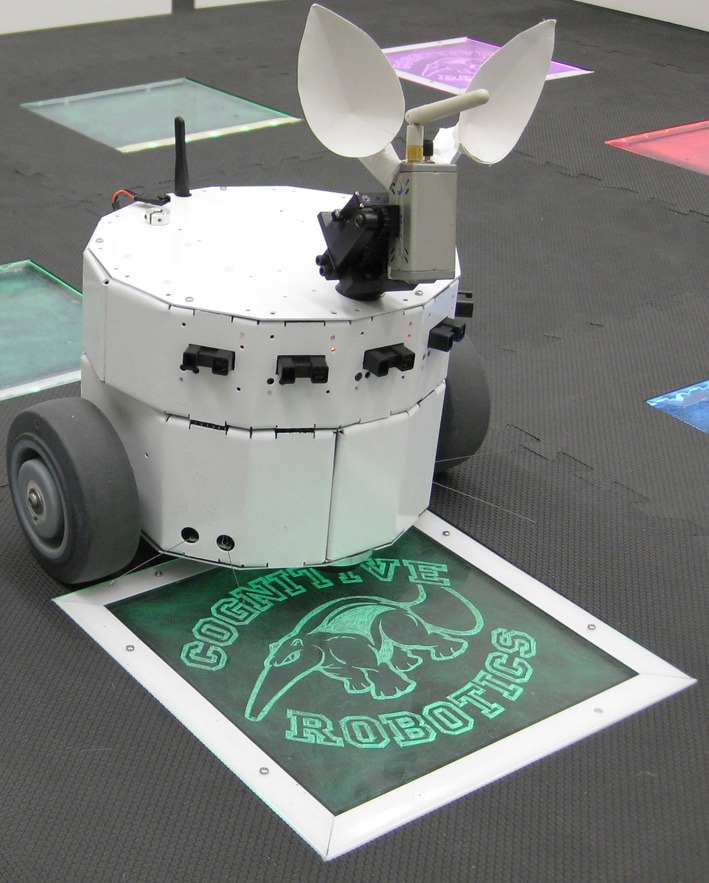Tuesday, May 21, 2013 | by admin
 Researchers have been developing robots that are powered by better artificial brains. They have recently created a computer neural simulation consisting of 6,700 neurons with approximately 1.3 million synaptic connections. This technology builds on previous work in the field of neurorobotics. The robot they used for this experiment is shown on the left. It is equipped with a CCD video camera. The camera has IR sensors to avoid obstacles and an RF transmitter to process objects visually. The emulation attempts to model aspects of the mind that researchers believe to be important for information processing. The goal is to allow the robot to act in a manner similar to an actual animal. This gives insight into the functioning of the brain and how it encodes for behavior.
Researchers have been developing robots that are powered by better artificial brains. They have recently created a computer neural simulation consisting of 6,700 neurons with approximately 1.3 million synaptic connections. This technology builds on previous work in the field of neurorobotics. The robot they used for this experiment is shown on the left. It is equipped with a CCD video camera. The camera has IR sensors to avoid obstacles and an RF transmitter to process objects visually. The emulation attempts to model aspects of the mind that researchers believe to be important for information processing. The goal is to allow the robot to act in a manner similar to an actual animal. This gives insight into the functioning of the brain and how it encodes for behavior.The scientists claim to have chosen three different neurotransmitters subsystems to model. These systems include dopamine, acetylcholine and serotonin. Dopaminergic, cholinergic and serotonergic cell bodies are found in the VTA, basal forebrain and raphe nucleus respectively. Some of these cells are located deep within the brain and they project their axons like a branching tree to numerous other regions. The synaptic junctions allow cross-talk between areas using these discrete neurotransmitters as messengers.
 The VTA for instance (see picture on left), makes connections to places like the nucleus accumbens and prefrontal cortex. The neural facsimile they carried out emulates 100 neurons for each of these three cell body regions. Their simulation also contains brain cells devoted to processing images from the CCD camera. In addition, they have areas to encode for find/flee behavior and good/bad judgements (100 neurons for each).
The VTA for instance (see picture on left), makes connections to places like the nucleus accumbens and prefrontal cortex. The neural facsimile they carried out emulates 100 neurons for each of these three cell body regions. Their simulation also contains brain cells devoted to processing images from the CCD camera. In addition, they have areas to encode for find/flee behavior and good/bad judgements (100 neurons for each).So this is really an extremely simplified replica that is merely meant to represent some very basic ways that the researchers believe how the mind works. Obviously 6,700 neurons is much less complex than even a fly's brain. They ignored a considerable amount of neuronal function. So the behavioral output of this robotic device is definitely limited in scope compared to more complicated organisms.
The researchers appear to give an overly simplistic explanation for how specific neurotransmitter systems function. So I'm not necessarily convinced of the utility in labeling the 100 neuron subpopulations as "dopaminergic" or "serotonergic". Their brain is really only a crude simulacrum and assigning these labels may not be particularly relevant.
Dopamine appears to be important for “wanting”, that is, the motivation process in acquiring an object [13]. Dopamine, which is found throughout the central nervous system, is produced in the ventral tegmental area. A recent proposal ties the prediction error to wanting by suggesting that incentive salience is the expected future reward that maps actions to rewards [14].There are a lot of nuances to dopamine's role in motivating an organisms to action and I'm not confident that the authors do it justice in their paper. Since this is done via computer, it does allow the scientists to do temporary lesions to see the resulting affect on robotic performances. They can basically turn off the functioning of specific neurotransmitter subsystems selectively. I'd be wary, though, of linking the behavioral changes that they witnessed to a real animal's dopaminergic system.
When CARL-1’s dopaminergic system was intact, it approached stimuli that were predictive of positive value, and ignored neutral stimuli. When CARL-1’s VTA was lesioned, the number of Find responses, which signify “wanting”, significantly decreased. Instead of approaching these positive-value stimuli, CARL-1 treated green objects as neutral stimuli.They go on to talk about the other neuromodulatory systems and how adjusting them altered the functioning of the neurobot.
In our experiments with CARL-1, we showed that serotonergic neuromodulation arising from a simulated Raphe nucleus was needed to respond appropriately to threatening stimuli. When CARL-1’s serotonergic system was intact, it moved away from threatening stimuli, and ignored neutral stimuli.The interpretations they make seem somewhat facile to me. However, I do think the interesting aspect of neurorobotics is that it allows the researchers to test an extraordinary range of different hypotheses. There is a lot of potential in scaling up the neuron count to enable a more extensive range of robot routines.
You can see some videos of this robot here. A recent paper on the topic is here (PDF). The researcher also gave a video presentation about it (see here, requires flash).
Labels: Neurobots